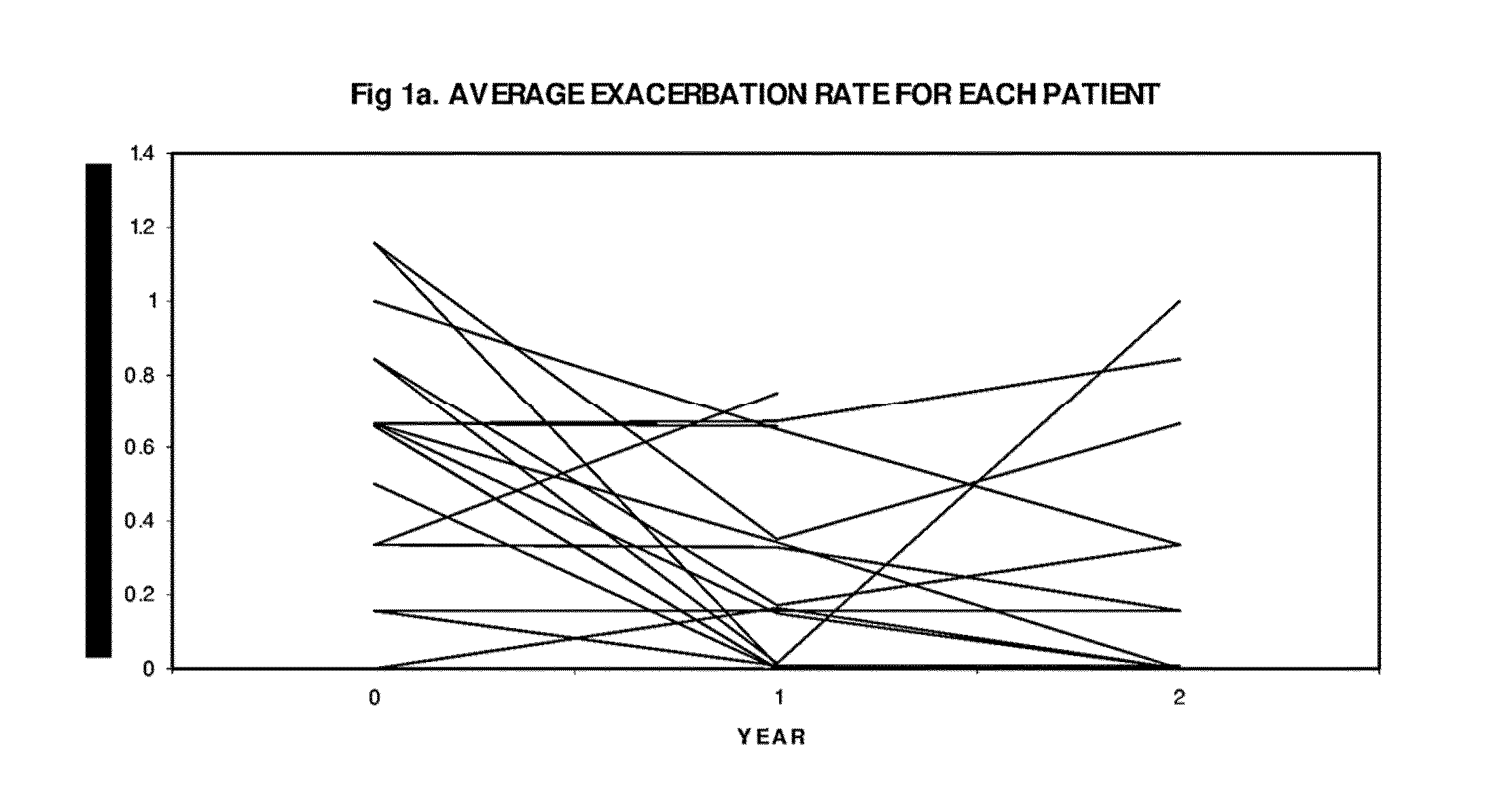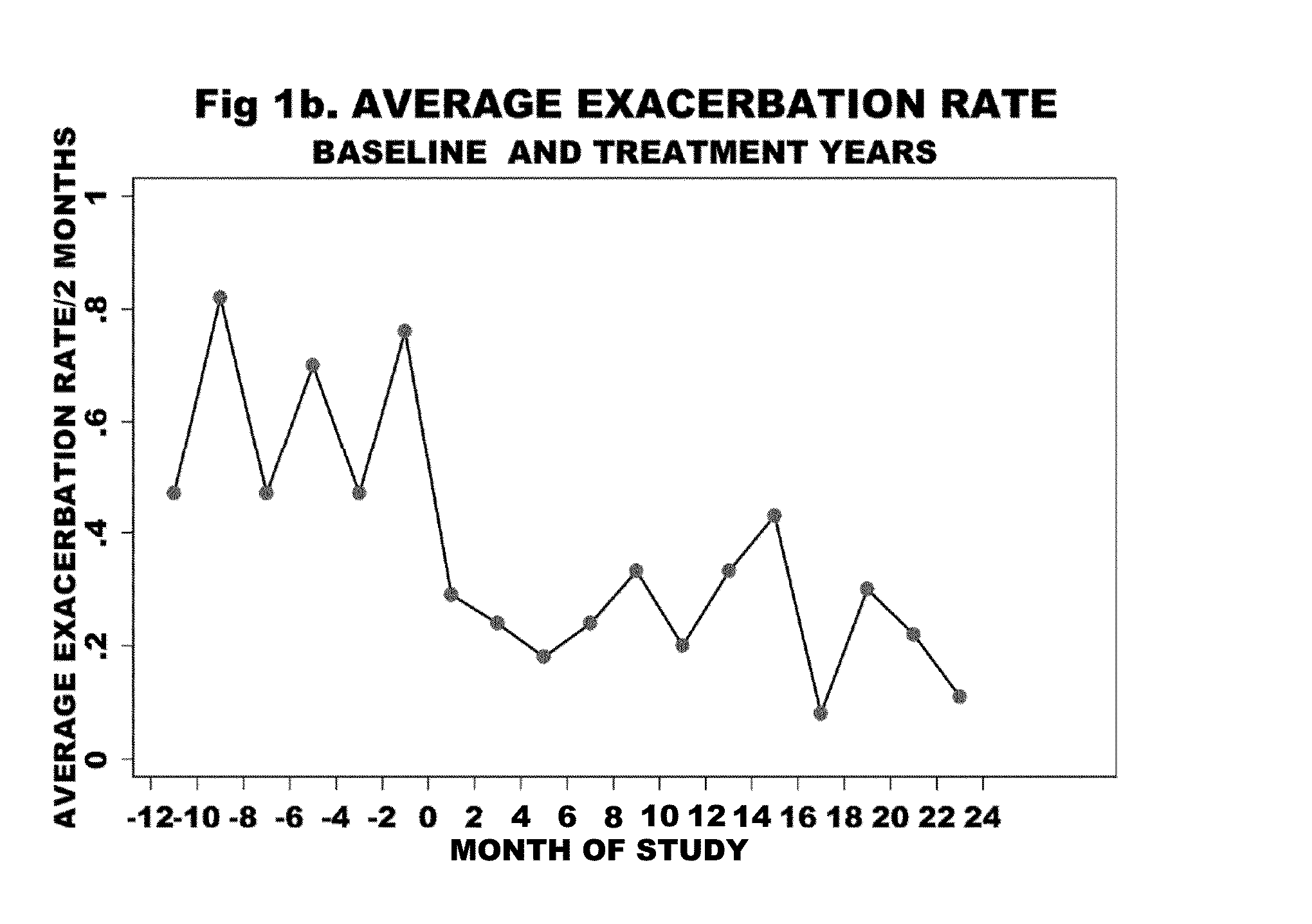Methods for treating chronic obstructive pulmonary disease
a technology for obstructive pulmonary disease and treatment methods, applied in the direction of antibody medical ingredients, drug compositions, peptides, etc., can solve the problems of shortened survival time, major healthcare costs of obstructive pulmonary disease, and loss of working capacity
- Summary
- Abstract
- Description
- Claims
- Application Information
AI Technical Summary
Benefits of technology
Problems solved by technology
Method used
Image
Examples
example i
Selection Criteria for Inclusion in the Evaluation Study
[0051]Testing of the usefulness of anti-IgE for the treatment of COPD was carried on 143 patients with symptoms requiring ongoing management. For each patient, age, sex, smoking history, and family history (1st degree relatives) of allergic or obstructive disease were recorded. Serum IgE was measured in International Units (IU). Serum eosinophil levels were measured in most cases. Atopy was evaluated with skin test reactivity to a panel of 24 relevant inhalant antigens according to guidelines of the American Academy of Allergy, and was scored on a severity scale of 0 to 3 (3=prick test reactivity with wheal>2 mm; 2=prick test reactivity with wheal<2 mm; 1=negative prick test reactivity with intradermal reactivity only; 0=no reactivity). The individual skin test scores were added to obtain a total skin test score. Pulmonary function tests (PFT) were performed on a Collins G.S. Spirometer according to American Thoracic Society gu...
example ii
Evaluation Study
Patients Demographics
[0055]The demographics of the 143 patients evaluated are presented in Table 1.
TABLE 1Patients with symptoms requiring ongoing management (Group 1-4)from which 17 patients were selected to receive Omalizumab.1234IgE >30 IUIgE Patient GroupsNon-Non-N = 143SmokersmokerSmokerSmokerNumber68203916Age range30-80 (65) 17-85 (53) 35-83 (65)39-84 (73)(median)Female21122713Family history 4517255of obstructive diseaseIgE (IU)32-1618 (110)31-858 (140)0-22 (7) 0-25 (6)(median)Positive skin41 / 4918 / 20*6 / 124 / 10testsEosinophilia 27 / 6212 / 19 7 / 344 / 15(>300)Reversibility 11540(>15%)Baseline >80161257FEV1 (%)50-80396169predicted) 132180*One additional patient in this group who was not skin tested had positive RAST panel.
[0056]There were 110 patients (72%) with a primary cigarette history (Groups 1+3), indicating a large proportion of patients with a cigarette history in this practice.
[0057]There were 88 patients (62%) with an IgE>30 IU (Groups 1+2), indicating a large...
example iii
Evaluation Study
Omalizumab Treatment Group
[0058]Of the 88 patients in with an IgE>30 IU, 17 were entered into the study (Table 2) on the basis of disease severity in the one year baseline period prior to treatment—16 patients had experienced a total of 60 acute exacerbations that resulted in 20 hospitalizations and 40 outpatient emergency room / doctor visits, while 1 patient was O2 and steroid dependant with 3 prior intubations (four patients, overall, were O2 dependant). They had severe obstructive disease—8 patients had an FEV1 of less than 50% predicted. There was minimal reversibility—5 patients of the 16 had reversibility>15%. The COPD severity score ranged from 11 to 28. Eight patients had positive skin tests to both indoor and outdoor allergens, 6 patients were positive to indoor allergens alone, and 2 patients were negative to skin testing as well as to RAST testing (Table 3).
TABLE 3Skin test reactivity to inhaled allergensNUMBER OF PATIENTSAVERAGEINHALEDTESTINGREACTIVITYALLE...
PUM
 Login to View More
Login to View More Abstract
Description
Claims
Application Information
 Login to View More
Login to View More - Generate Ideas
- Intellectual Property
- Life Sciences
- Materials
- Tech Scout
- Unparalleled Data Quality
- Higher Quality Content
- 60% Fewer Hallucinations
Browse by: Latest US Patents, China's latest patents, Technical Efficacy Thesaurus, Application Domain, Technology Topic, Popular Technical Reports.
© 2025 PatSnap. All rights reserved.Legal|Privacy policy|Modern Slavery Act Transparency Statement|Sitemap|About US| Contact US: help@patsnap.com



